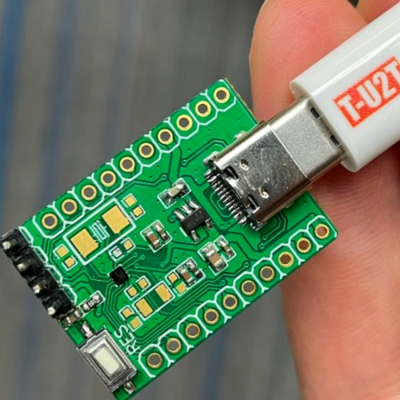Not a rhetorical question! This week we consider the most micro microcontroller: the HC32L110. It’s the new title holder of the smallest ARM Cortex M0+ part. But could you actually use it?

I remember way back, when I first learned to solder surface-mount components. It was fiddly at first, but nowadays I don’t use through-hole components unless someone’s twisting my arm. And I still do my soldering myself — down to 0603 really isn’t all that bad with an iron, and below that, there’s always the heat plate. My heat plate has also gotten me through the two times I’ve actually needed to put down a ball-grid-array part. It wasn’t as bad as I had feared, honestly.
So maybe it’s time for me to take the BGA plunge and design a board or two just to get more familiar with the tech. I probably won’t dive straight into the deep end, like the featured chip here with 0.35 mm ball pitch, but rather stick with something that the cheap PCB services can easily handle. My experience tells me that the best way to learn something is just to test it out.
Now, off to go part shopping in the middle of a chip crisis! Wish me luck.
















Wrong. It’s an ‘RCH’.
What has a Royal Children Hospital to do with this? Google came with a lot of other explanations RCH but non that matches this article.
LOL. But then again, if you look at the “Alice in Wonderland” artwork for this post, that comes pretty close to what Jim is describing ;)
Yes, pretty close. And the answer was definitely not in google. Just a vulgar , sexist slang:
https://www.urbandictionary.com/define.php?term=rch
The (Chinese) datasheet describes it as a CSP16 package rather than BGA16
We need to have cheap boardhouses that can do this fine pitchef stuff. Soldering bga is ‘simple’ with an oven and proper stencil.
Do you give away pcbs? I like to have a go.
Luckily this mcu comes in other packages too :)
PCBWay (and a few other places overseas) will do this level of assembly for shockingly low prices, if you can wait 3-4 weeks.
At 0.35 mm pitch? That’s 14 mil spacing. At that you need via-in-pad *and* blind vias. They can do it, but it’s still ~$500. Shockingly cheap compared to years ago, but not compared to the sub-$50 4 layer boards we have now. Unless there’s another trick I don’t know.
For what it’s worth, I’ve gotten 0.35mm pitch CSP/BGA parts to work on the $2 JLC boards before! It’s not something I’d do on a “real” board, but it’s doable. 5 mil traces, 5 mil clearances; not officially allowed by JLC (I think) but I haven’t had any production issues yet.
Not much of a trick to it: to get to any of the inner pins, I’d have to run sacrifice a neighboring outer pin. For example, on the WLCSP ATtiny20, the GND pin is blocked on all sides by other pins, so you just choose a GPIO nearby and accept that it will be tied to ground forever. I can’t use the chip to its fullest potential, but no need to pay for microvias; I’m happy with that tradeoff :)
(also worth noting: for those HASL $2 boards I was very careful to solder-wick off as much of the HASL as I could before putting the CSP chip down)
Yeah obviously if you don’t care about certain pins, it’s fine, but just depends on the pinout. With a 16 pin you can also get away with *just* via-in-pad to save a bit of money, but not much.
If there’s one process I’d love to see cheap, that’d probably be it.
I thought JLC’s limit was 0.4mm?
I’d be very interested to see your design / process for this.
.aaaand it’s gone. Another article is in my print queue.
Indeed I do wish you luck – I’ve just given up on projects I was at the order parts for stage, at least for now – Finding anything IC wise that did what I wanted in small enough quantities at a sane price just wasn’t happening…
(haven’t looked again since, so maybe the supply of that particular selection of chips has improved – but with only so much project space once a project gets shelved the next one that can be worked on is then blocking it, not helped by being permanently penniless at the moment)
Some of the scarcest chips like the Realtek Ethernet chips that shot up from $1 to over $12 (and if contacted, the seller didn’t actually have any) and briefly to $20 are back down in reasonable land. AT least some things are settling. Internation shipping by air is still way up and fuel prices are not going help that.
The issue with really fine stuff, finer than 0603 or SMD packages with pitches below 0.8mm is you really can only ever do it with solder paste. And while I have pasted before, and it works well. You need quite a setup to do it, whole load of air compressor stuff to pipe air to the paste needle, and buying paste is tricky as it tends to need refrigerated delivery. 0603 isn’t at all unpleasant to hand solder with any fine tipped iron and some half-ok magnification.
I’ve had no trouble soldering 0.4mm QFP with normal non-smd tools.
Can you use stencils for sub-0603 parts? I use stencils for my smd assembly and they work great. I rarely use anything smaller than 0603, I think the tightest spacing is mcus with 0.5mm pin pitch. No air compressor needed.
Also, if you just chipquik brand solder paste, they recommend refrigerating it, but they say it will still work fine if you don’t. I don’t want to run a separate fridge just for it nor risk cross contamination, so I just store it on the shelf. It does get a little thick, but lasts at least a year.
I’ve fixed bridges or occasionally hand-soldered at those sizes too, it’s fine, if not my favorite.
I do rework on 0402 with solder wire, a fine tip, and a analog stereo microscope on a regular basis. I’ve done assembly of entire 2 inch square boards like this too. Its not fast, but with some patience it is possible. I’d not do more that a couple of a single design this way due to time costs.
You don’t need any fancy tools to do the paste either. Stencils are nice, but not necessary. We use needles to place the paste. Tweezers work well to place the components, and a stereo microscope for rework is extremely helpful for both 0603 and 0402, but with a loupe or magnifying glass it is still possible. The question is if it is worth the time for your design? Most of the time I find it’s not worth the effort, and I’d rather pay a board house. Most often I end up doing rework this way, and melting the solder with a cheap heat gun from EBay.
I draw the line at 0201s. I can’t solder those, with or without paste, for the life of me. If it’s going to be that small, it’s going to have to go to a pick and place machine.
I remember that there was an ARM chip in an 8 pin DIP or SO package. That would obviously be a lot bigger than that tiny BGA in terms of physical size, but as far as I know, in terms of pin count it’s the smallest 32 bit microcontroller out there.
I suppose the limited application of such a powerful microcontroller with so few pins is why there aren’t many that small. Cryptographic applications and DSP are the only ways I can think of to use that much power with few pins.
oh no, far from it. Anywhere where saving mass is desired, or the place is very scarce. That could be drone electronics, packaged sensors… i´m sure one can find way more applications where the size and weight is THAT important. The reduced number of pins is still perfectly suitable for many applications, just look where the famous ATtiny where put in use. In some cases, extra computing power would have been a must, not forcing the developers to squeeze every bit of program by coding in assembler.
You mean this one: https://smdprutser.nl/blog/the-arm-chip-that-wont-cost-an-arm-and-a-leg/ ?
not very usefull compared to the one featured here. That has proper peripherals instead of bitbangings stuff and more memory.
NXP LPC810s… they’re no longer manufactured.
I am tired by crap-chinese-chip-with-no-documentation. I am tired to to be a-beta-tester-that-must-pay-to-test.
Not me, not this time, no anymore.
My biggest worry with relying on goods and services that come from Chinese territory is not so much the product or service, but its availability given the way the various governments are sanctioning each-other right now.
Suppose I became reliant on the Expressif ESP32 for some design I was building… Now, consider that China currently is being barred access to some of the more advanced 5G chipsets, let’s pretend they applied a little tit-for-tat by saying “Well, you’re not allowed to sell us 5G cellular modem chipsets, we won’t sell you ESP32s”.
Now I’ve got to re-work my design around an alternative (how many alternatives are there exactly?) or suspend sales of my formerly ESP32-based widget altogether.
Likewise with PCB-fabrication… I used to be quite happy with Smart Prototyping, who are based in Hong Kong… but how long will they be an option for? The pandemic has all but totally shut down all my home prototyping, so my demand for these services has diminished, but when I resume, I’m looking to elsewhere just to avoid being reliant on a supplier who may not “be there” tomorrow due to international politics.
If someone knows a service in Australia, US, Europe (except Russia… and maybe not Ukraine until things settle down) that could do these small-pitch footprints… maybe it’s worth swallowing the extra cost for a bit of certainty?
China will hardly restrict the export of something unless it’s clearly a threat to them (weapon components), more likely they will just forbid a US company from operating on their market or give a very unfair advantage to domestic competition to said company.
Personally I wouldn’t import anything from China right now. Just out of principle alone.
There is a lot of board assembly houses in Europe, the Americas, Australia, the middle east and elsewhere in Asia.
They are typically not that hard to find, a bit of searching and one can typically find a few.
Searching in the local language is usually the best way to find them. Some though also market themselves in English, but most don’t.
There isn’t any reasonably priced board houses in Australia that don’t just send the FAB work to China.
You mention above that you would not buy from China “on principle.” Well, that “principle” has a cost. It’s up to you to decide whether the cost of your “principle” also aligns with your definition of “reasonable.”